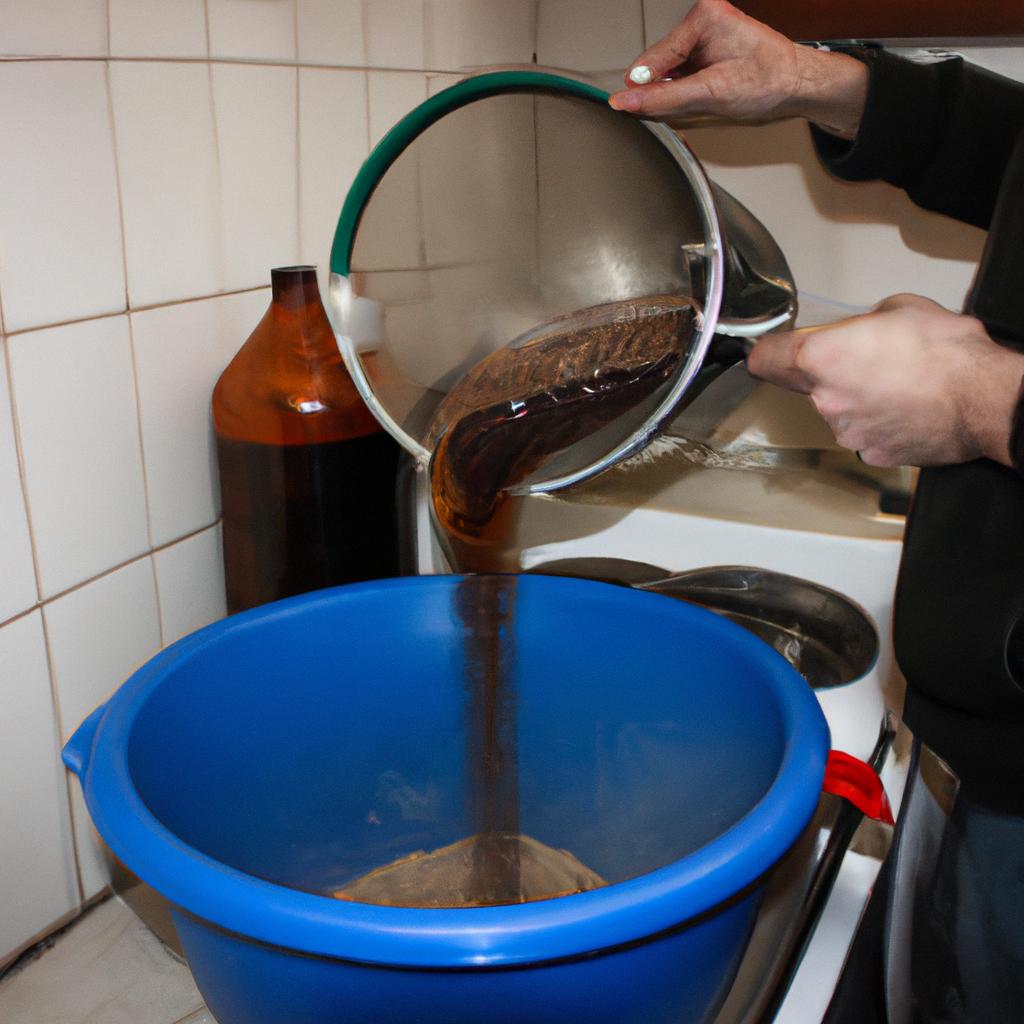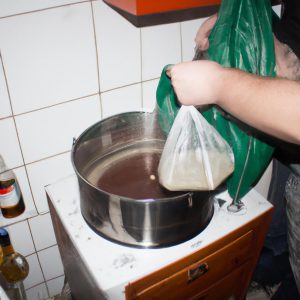Water Chemistry and Beer Reviews: Essential Homebrewing Tips

Water chemistry is a critical factor in the homebrewing process, directly impacting the taste and quality of beer. By understanding the intricacies of water composition and its effect on brewing, enthusiasts can enhance their ability to create exceptional beers. This article aims to provide essential tips for homebrewers by exploring the fundamental principles of water chemistry and presenting practical guidance on how to optimize it.
To illustrate the significance of water chemistry in brewing, let us consider a hypothetical scenario involving two brewers attempting to make an IPA (India Pale Ale). Brewer A uses tap water with high levels of alkalinity, while Brewer B invests in reverse osmosis filtered water with low mineral content. Despite using identical ingredients and following similar recipes, they notice distinct differences in flavor profiles between their respective IPAs. The disparity arises from variations in water chemistry; specifically, alkaline tap water affects hop bitterness perception due to increased pH levels, whereas low mineral content enhances hop aroma and produces a crisper finish. This example highlights the crucial role that water plays as one of the primary components in beer production and emphasizes the importance of understanding its chemical characteristics.
Understanding Water Chemistry for Homebrewing
Water is a fundamental ingredient in the brewing process, playing a crucial role in determining the flavor and quality of beer. By understanding water chemistry, homebrewers can gain greater control over their brews and achieve desired outcomes consistently. For example, let’s consider a hypothetical case where two brewers use different water sources: one from a well with high mineral content and another using tap water treated through reverse osmosis.
To fully comprehend the impact of water on brewing, it is essential to examine its chemical composition. The main components that influence water chemistry for brewing are minerals such as calcium, magnesium, bicarbonates, sulfates, and chlorides. These elements affect various aspects of the brewing process, including mash pH levels, enzyme activity, yeast health, hop utilization, and overall taste profile.
In order to adjust their water appropriately for optimal brewing conditions, homebrewers often rely on specific measurements and calculations. Here is an example bullet point list outlining some key considerations:
- Understanding the alkalinity level of your water source
- Adjusting mash pH by adding acid or alkaline agents
- Balancing mineral content based on beer style guidelines
- Incorporating salts to enhance certain flavors
Furthermore, visualizing information through tables can help convey complex data effectively. Consider this three-column table displaying recommended ranges for different ions commonly found in brewing water:
| Ion | Ideal Range (ppm) | Flavor Contribution |
|---|---|---|
| Calcium | 50 – 150 | Enhances bitterness |
| Magnesium | 10 – 30 | Promotes yeast health |
| Sulfate | 50 – 150 | Adds crispness |
| Chloride | 0 – 100 | Improves maltiness |
By mastering these principles of water chemistry and employing appropriate adjustments when necessary, homebrewers can create beers that are well-balanced, consistent, and true to their intended style. Understanding the impact of water on beer flavor is a crucial step towards achieving brewing excellence. In the subsequent section, we will delve deeper into how different aspects of water chemistry influence specific flavors in beer.
The Impact of Water on Beer Flavor
In the previous section, we explored the fascinating world of water chemistry and its crucial role in homebrewing. Now, let’s delve deeper into understanding how different aspects of water can impact the flavor profile of your beer.
Imagine you are brewing a classic German-style Pilsner. You carefully select high-quality malt and hops to achieve that crisp, clean taste characteristic of this style. However, if you neglect to consider the composition of your brewing water, you may end up with a subpar brew lacking the desired balance and character.
To fully grasp the importance of water chemistry in homebrewing, here are some key factors to keep in mind:
-
pH Level: The acidity or alkalinity of your brewing water can significantly influence enzymatic activity during mashing and fermentation processes. A pH level outside the optimal range might result in incomplete conversion of starches into sugars or affect yeast performance.
-
Mineral Content: Different minerals present in your brewing water contribute unique flavors and characteristics to your final product. For example, higher levels of calcium can enhance hop bitterness perception while magnesium content affects yeast health and ester formation.
-
Chlorine/Chloramine: Tap water commonly contains chlorine or chloramine as disinfectants. These compounds can adversely impact both aroma and flavor profiles by producing off-flavors reminiscent of plastic or medicinal notes.
-
Carbonate Hardness: Carbonate hardness determines the buffering capacity of your brewing water against changes in pH during various stages like boiling and fermentation. It is essential to understand carbonate hardness when adjusting mash pH for specific beer styles.
Now, let’s take a closer look at how these factors come together by examining their effects on three popular beer styles – American IPA, Belgian Witbier, and Irish Stout:
| Beer Style | Optimal pH Range | Desirable Minerals | Undesirable Elements |
|---|---|---|---|
| American IPA | 5.2-5.6 | High sulfate, low chloride | Chlorine/chloramine |
| Belgian Wit | 5.4-5.8 | Moderate calcium | Excessive magnesium levels |
| Irish Stout | 5.3-5.7 | Balanced carbonate hardness | Elevated sodium content |
By understanding and carefully manipulating your brewing water’s chemistry, you can tailor it to suit the specific requirements of each beer style, maximizing flavor potential.
Now that we have explored the impact of water on beer flavors, let’s move forward by discussing an equally important step – choosing the right water source for homebrewing success.
Choosing the Right Water Source
In the previous section, we discussed how water plays a crucial role in shaping the flavor profile of beer. Now, let’s delve deeper into the process of choosing the right water source for homebrewing and its implications.
Imagine you’re brewing a classic American Pale Ale with two different water sources: one from a local well and another from a municipal supply. The well water is known to be high in mineral content, while the municipal supply undergoes extensive treatment processes. Upon fermentation, you notice subtle differences in taste between the two batches. This scenario highlights the importance of understanding your water source and its impact on your final product.
To ensure that your chosen water source aligns with your desired beer style, consider these key factors:
- Mineral Content: Different styles of beer require varying levels of minerals such as calcium, magnesium, sodium, and sulfate ions. Adjusting these mineral concentrations can enhance specific characteristics like hop bitterness or malt sweetness.
- pH Level: The pH level of your brewing water affects enzymatic activity during mashing and influences yeast performance during fermentation. Maintaining an appropriate pH range helps achieve optimal extraction of flavors from grains and ensures proper yeast health.
- Chlorine/Chloramine Levels: Chemical disinfectants like chlorine or chloramine are often added to tap water supplies but can adversely impact the aroma and flavor of brewed beer. Understanding their presence will guide you towards suitable treatment methods.
- Local Water Profiles: Exploring historical brewing traditions in your region can provide valuable insights into successful recipes that have been developed using locally available water sources.
Consider this table showcasing examples of popular beer styles alongside their recommended mineral profiles:
| Beer Style | Calcium (ppm) | Magnesium (ppm) | Sodium (ppm) | Sulfate (ppm) |
|---|---|---|---|---|
| Pilsner | 50 | 10 | 5 | 5 |
| IPA | 75 | 20 | 25 | 75 |
| Stout | 100 | 30 | 15 | 50 |
By understanding the impact of water on beer flavor and carefully selecting your water source, you can create a harmonious balance of flavors in your homebrews. In our next section, we will explore methods for adjusting water pH and mineral content to further refine the brewing process.
Adjusting Water pH and Mineral Content
Having discussed the importance of choosing the right water source for homebrewing in the previous section, let us now delve into the next crucial step in water chemistry – adjusting water pH and mineral content. To illustrate its significance, consider a hypothetical scenario where two brewers use identical ingredients and brewing techniques, but one adjusts their water while the other does not. The brewer who carefully adjusts their water is likely to produce a beer with better flavor and overall quality.
One key aspect of achieving optimal water chemistry for homebrewing involves adjusting the pH level. The ideal pH range for mash conversion typically falls between 5.2 and 5.6. A higher or lower pH can result in poor enzyme activity during mashing, which may lead to incomplete starch conversion or off-flavors in the final product.
To ensure proper adjustment of pH levels, brewers often rely on various methods such as adding acid or alkaline substances. However, it is important to note that excessive adjustments can also negatively impact the beer’s flavor profile. Striking a balance by testing and gradually making corrections ensures an appropriate environment for enzymes to convert starches into fermentable sugars.
Alongside pH adjustment, manipulating mineral content plays a significant role in enhancing different styles of beer. Brewers aim to replicate specific regional profiles by mimicking local water characteristics through additions known as brewing salts. These salts not only affect taste but also influence factors like mouthfeel and clarity.
Consider the following emotional response-inducing bullet points:
- Enhancing hop flavors with sulfate-rich water
- Creating malt-forward beers using calcium chloride
- Achieving crispness with low-mineral-content brewing water
- Emulating traditional European styles with high carbonate levels
Table: Examples of Brewing Salts Effects
| Salt | Effect |
|---|---|
| Gypsum | Enhances bitterness; sharpens hop flavor |
| Calcium Chloride | Improves malt sweetness; adds body |
| Epsom Salt | Enhances hop bitterness |
| Baking Soda | Increases alkalinity |
Understanding the importance of adjusting water pH and mineral content sets the stage for exploring various water treatment methods commonly employed in homebrewing. In the subsequent section, we will dive into these methods to further optimize the brewing process.
[Next Section H2: Water Treatment Methods for Homebrewing]
Water Treatment Methods for Homebrewing
Transition: Building on the importance of adjusting water pH and mineral content in homebrewing, we now delve into various water treatment methods that can further enhance the quality of your beer. Let us explore some effective techniques to ensure optimal water chemistry for brewing.
Water Treatment Methods for Homebrewing
To illustrate the significance of water treatment, consider a hypothetical scenario where two brewers use identical ingredients and recipes but employ different water treatment methods. Brewer A uses untreated tap water, while Brewer B implements appropriate treatment measures based on their local water profile analysis. The difference in taste and overall beer quality between these two batches is likely to be remarkable. This example highlights how careful consideration of water treatment can significantly impact the final product.
When it comes to treating brewing water, several methods are commonly employed:
- Filtration: Filtration systems remove impurities such as chlorine, sediment, or heavy metals from tap water.
- Reverse Osmosis (RO): RO systems utilize pressure to force water through a semi-permeable membrane, effectively removing contaminants and minerals.
- Boiling: Boiling helps eliminate volatile compounds like chlorine or chloramine present in tap water.
- Chemical Additives: Brewing salts and additives can be used to adjust mineral content and pH levels according to specific beer styles.
While each method has its advantages and limitations, understanding your local water characteristics will guide you in selecting an appropriate technique. Conducting a thorough analysis of your source water’s chemical composition is crucial before deciding on any particular method.
| Water Treatment Method | Pros | Cons |
|---|---|---|
| Filtration | Removes impurities | Limited removal of minerals |
| Reverse Osmosis | Complete purification | Expensive initial setup |
| Boiling | Simple process | Does not alter mineral content |
| Chemical Additives | Precise adjustment | Requires accurate measurement |
Implementing effective water treatment methods is a vital step toward achieving desired brewing outcomes. By carefully selecting and applying the appropriate technique based on your specific water profile, you can optimize the flavors, aromas, and overall quality of your beer.
Transition: Now that we have explored various water treatment methods, let us shift our focus to enhancing beer quality with proper water chemistry.
Enhancing Beer Quality with Proper Water Chemistry
In the previous section, we discussed various water treatment methods for homebrewing. Now, let us delve into how proper water chemistry can significantly enhance the quality of your beer. To illustrate this point, let’s consider a hypothetical scenario involving two batches of pale ale brewed using different water profiles.
Imagine you brew one batch of pale ale using tap water that has not been treated or adjusted in any way. For comparison, you also brew another batch using properly treated and adjusted water according to specific style guidelines. The difference between these two beers will be remarkable when it comes to their overall flavor profile, clarity, and mouthfeel.
Enhancing beer quality through water chemistry involves several key factors:
- pH Balance: Adjusting the pH level of brewing water is crucial as it affects enzymatic activity during mashing and impacts the final taste of the beer.
- Mineral Content: Different styles of beer require varying levels of minerals like calcium, magnesium, and sulfates to achieve desired flavors and balance.
- Ion Concentration: Controlling ion concentration influences hop utilization, yeast performance, and overall fermentation characteristics.
- Chlorine/Chloramine Removal: Removing chlorine or chloramine compounds from brewing water helps prevent off-flavors caused by chemical reactions with organic matter during fermentation.
To better understand how these factors affect beer quality, consider the following table showcasing the impact of different mineral additions on a classic American Pale Ale:
| Mineral Addition | Flavor Contribution | Recommended Amount |
|---|---|---|
| Calcium (Ca) | Crispness | 50 – 150 ppm |
| Magnesium (Mg) | Smoothness | 10 – 30 ppm |
| Sulfate (SO4) | Bitterness enhancement | 100 – 350 ppm |
| Chloride (Cl) | Malty sweetness | 50 – 100 ppm |
By carefully adjusting the water chemistry, you can create a balanced and harmonious flavor profile in your beer. Remember that every style has its own specific requirements, so understanding these nuances is crucial for achieving exceptional results.
In summary, proper water chemistry plays a vital role in enhancing the quality of homebrewed beer. Adjusting pH levels, mineral content, ion concentration, and removing unwanted compounds like chlorine or chloramine are essential steps towards brewing great-tasting beers. By considering each factor and tailoring them to meet the needs of different beer styles, you can elevate your brewing game and craft truly outstanding beverages.



